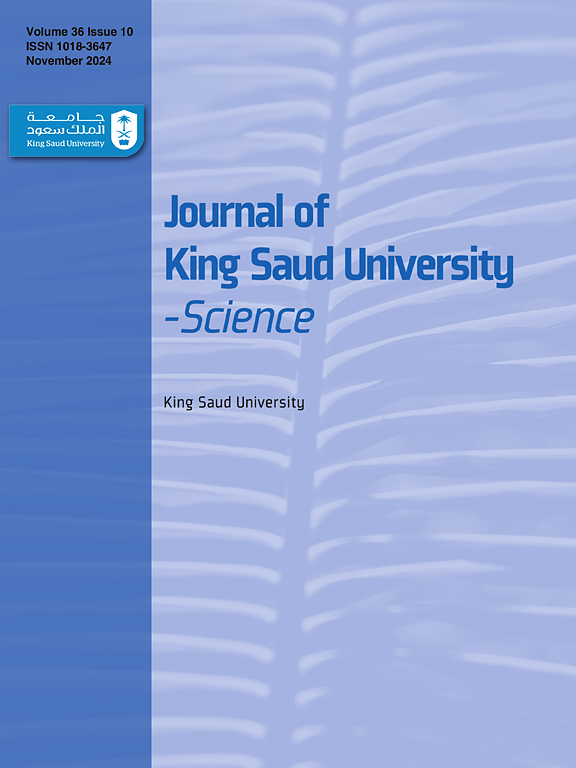形态生理特征和胁迫指数揭示了精英大豆种质对早期盐胁迫反应的差异
IF 3.7
3区 综合性期刊
Q1 MULTIDISCIPLINARY SCIENCES
引用次数: 0
摘要
本研究将大豆幼苗置于 0、75、100 和 125 毫摩尔浓度的氯化钠(NaCl)环境中,评估了 70 种大豆基因型的盐胁迫反应。盐胁迫明显降低了根长、芽长、根/芽鲜重和干重以及根/芽比。共有 62 个基因型在 125 毫摩尔浓度下发芽,在根长、芽长、芽鲜重和芽干重等性状上表现出显著的表型差异。皮尔逊相关分析表明,大多数形态生理性状之间存在很强的正相关性,表明它们之间存在相互依存关系。计算了八个耐盐指数,即鲜重胁迫耐受指数(FWSI)、干重胁迫耐受指数(DWSI)、根长盐度指数(RLSI)、芽长盐度指数(SLSI)、盐度耐受指数(STI)、盐度敏感指数(SSI)、耐受指数(TI)和减少百分比(PR),以评估基因型的响应。与对照相比,盐胁迫下 Na+ 浓度和抗氧化活性显著增加。与对照相比,盐胁迫下抗氧化酶的活性以及活性氧(ROS)(如 H2O2 和 O2-)的水平明显升高。层次聚类分析将基因型分为六个聚类,其中聚类 V 和 VI 由耐盐性较高的基因型组成,这些基因型的 FWSI、DWSI 和 STI 值较高,而 PR、SSI 和 TI 值较低。研究采用了八个耐盐指数来评估基因型的反应,包括鲜重耐盐指数(FWSI)、干重耐盐指数(DWSI)、根长耐盐指数(RLSI)和耐盐性指数(STI)。研究表明,所有处理下基因型的平均 FWSI 值为 54.20 ± 12.93。基因型 Black 的 FWSI 值最高(92.52),其次是 NIBGE-224(84.70)和 NIBGE-183(81.05)。相比之下,马拉坎-96 的 FWSI 最低(28.49),其次是 SPS-10(32.74)和 SPS-08(34.55)。PGRA-91 的 STI 值最高(0.83),其次是 SPS-9(0.75)和 NIBGE-115(0.72),而 NIBGE-335、SPS-24 和 Malakand-96 的 STI 值最低。根长与芽长(0.69**)、芽长与鲜笋重(0.63**)及其他相关性状之间呈正相关。总之,本研究发现了具有不同耐盐性的大豆基因型。这些发现可用于育种计划,为受盐碱影响的农田培育耐盐大豆品种。本文章由计算机程序翻译,如有差异,请以英文原文为准。
Morpho-physiological traits and stress indices reveal divergence in early-stage salt stress response in elite soybean germplasm
This study assessed the salt stress response of seventy soybean genotypes by exposing seedlings to sodium chloride (NaCl) concentrations of 0, 75, 100, and 125 mM. Salinity stress significantly reduced root length, shoot length, fresh and dry root/shoot weight, and root/shoot ratio. A total of 62 genotypes germinated at 125 mM, showing significant phenotypic variation in traits such as root length, shoot length, fresh shoot weight, and dry shoot weight. Pearson’s correlation analysis revealed a strong positive correlation between most morpho-physiological traits, suggesting their interdependence. Eight salinity tolerance indices i.e., Fresh Weight Stress Tolerance Index (FWSI), Dry Weight Stress Tolerance Index (DWSI), Root Length Salinity Index (RLSI), Shoot Length Salinity Index (SLSI), Salinity Tolerance Index (STI), Salinity Susceptibility Index (SSI), Tolerance Index (TI), and Percent Reduction (PR) were calculated to assess genotypes response. Na+ concentration and antioxidant activities significantly increased under salt stress compared to the control. The activities of antioxidant enzymes, as well as the levels of reactive oxygen species (ROS) such as H2O2 and O2−, were markedly higher under salt stress compared to the control. Hierarchical cluster analysis grouped genotypes into six clusters, with clusters V and VI comprising genotypes exhibiting higher salt tolerance based on high FWSI, DWSI, and STI values, and low PR, SSI, and TI values. Eight salinity tolerance indices, including Fresh Weight Stress Tolerance Index (FWSI), Dry Weight Stress Tolerance Index (DWSI), Root Length Salinity Index (RLSI), and Salinity Tolerance Index (STI), were used to evaluate the genotypes’ responses. The study revealed that the average FWSI value for all genotypes under treatments was 54.20 ± 12.93. The highest FWSI was recorded for the genotype Black (92.52), followed by NIBGE-224 (84.70) and NIBGE-183 (81.05). In contrast, Malakand-96 had the lowest FWSI (28.49), followed by SPS-10 (32.74) and SPS-08 (34.55). PGRA-91 had the highest STI (0.83), followed by SPS-9 (0.75) and NIBGE-115 (0.72), while NIBGE-335, SPS-24, and Malakand-96 had the lowest STI values. Positive correlations were observed between root length and shoot length (0.69**), shoot length and fresh shoot weight (0.63**), and other related traits. Overall, this study identified promising soybean genotypes with varying degrees of salt tolerance. These findings can be utilized in breeding programs to develop salt-tolerant soybean varieties for salinity-affected agricultural lands.
求助全文
通过发布文献求助,成功后即可免费获取论文全文。
去求助
来源期刊

Journal of King Saud University - Science
Multidisciplinary-Multidisciplinary
CiteScore
7.20
自引率
2.60%
发文量
642
审稿时长
49 days
期刊介绍:
Journal of King Saud University – Science is an official refereed publication of King Saud University and the publishing services is provided by Elsevier. It publishes peer-reviewed research articles in the fields of physics, astronomy, mathematics, statistics, chemistry, biochemistry, earth sciences, life and environmental sciences on the basis of scientific originality and interdisciplinary interest. It is devoted primarily to research papers but short communications, reviews and book reviews are also included. The editorial board and associated editors, composed of prominent scientists from around the world, are representative of the disciplines covered by the journal.
 求助内容:
求助内容: 应助结果提醒方式:
应助结果提醒方式:


